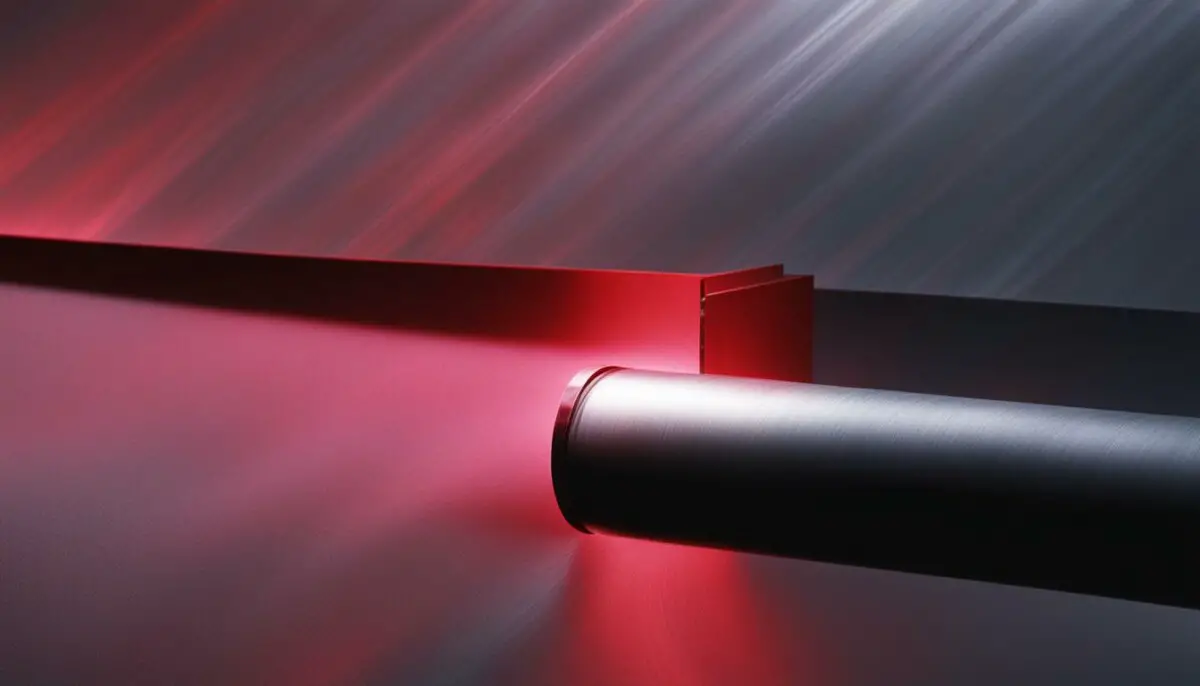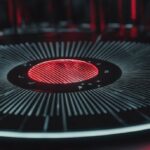Last Updated on 5 months by Francis
Welcome to our exploration of the fascinating interaction between infrared light and electrons. In the world of quantum physics, researchers have delved into the mechanisms behind electron ejection induced by infrared light. This phenomenon, known as the laser-assisted photoelectric effect, has opened up new possibilities for understanding ultrafast electron processes in materials.
But what exactly is the mechanism behind electron ejection by infrared light? How does the interaction between these two elements work? Join us as we delve into the intricate dance of electrons and the role that infrared light plays in their behavior.
Contents
Key Takeaways:
- Intense infrared light can boost or retard the emission of electrons from a solid surface.
- The photoelectric effect occurs when light causes the ejection of electrons from a solid surface.
- Infrared light, when combined with ultraviolet light, enhances or inhibits electron emission from a solid surface.
- Experimental studies have confirmed the existence of infrared light-induced electron ejection.
- Understanding the interaction between infrared light and electrons has implications for various scientific fields and technological advancements.
The Photoelectric Effect: A Brief Overview
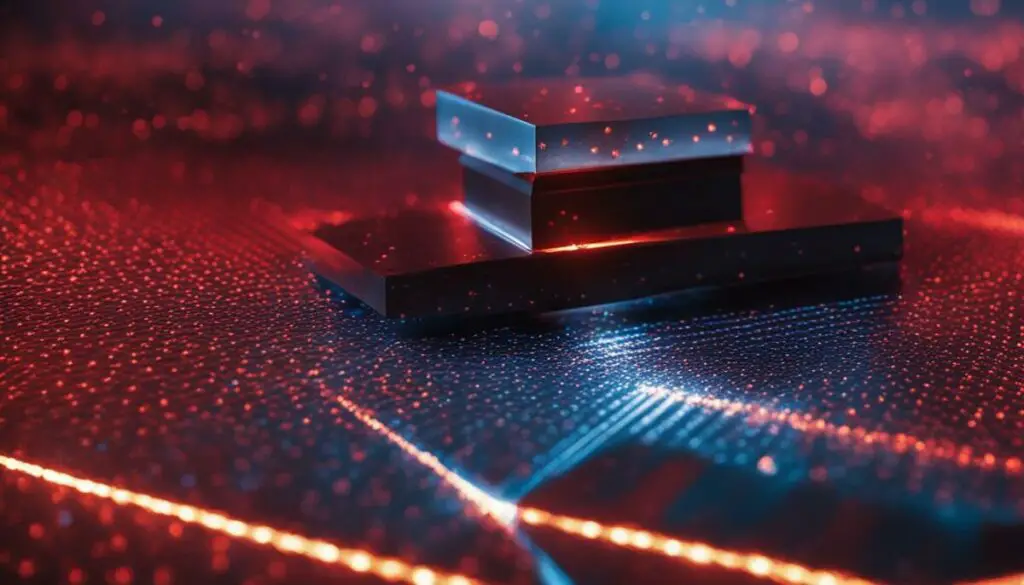
The photoelectric effect is a phenomenon that occurs when light shone onto a solid surface causes the ejection of electrons from that surface. It was first discovered and explained by Albert Einstein in the early 20th century.
According to Einstein’s theory, light consists of quanta of energy called photons, and when these photons interact with electrons in a material, they can transfer enough energy to eject the electrons. The photoelectric effect is dependent on factors such as the frequency and intensity of the incident light, as well as the characteristics of the material being illuminated.
Understanding the photoelectric effect is crucial as it forms the foundation for studying the interaction between light and matter. This phenomenon has significant implications in various scientific fields, including quantum physics, materials science, and nanotechnology.
Experimental Observations
Experimental studies have confirmed the existence of the photoelectric effect. Scientists have conducted experiments illuminating solid surfaces with different frequencies and intensities of light to observe the ejection of electrons.
| Frequency of Light | Effect on Electron Ejection |
|---|---|
| Low Frequency | No electron ejection |
| High Frequency | Increased electron ejection |
| Certain Threshold Frequency | Immediate and complete electron ejection |
This table showcases the relationship between the frequency of light and the effect on electron ejection. It demonstrates that the threshold frequency plays a crucial role in initiating the immediate and complete ejection of electrons.
“The energy of a photon is directly proportional to its frequency.” – Albert Einstein
This quote from Albert Einstein highlights the fundamental relationship between the energy of a photon and its frequency, which underlies the mechanism of the photoelectric effect.
The Role of Infrared Light in Electron Ejection

Infrared light, positioned between visible light and microwaves on the electromagnetic spectrum, plays a vital role in the process of electron ejection. Research has shown that intense infrared light can interact with ultraviolet light to either enhance or inhibit the emission of electrons from a solid surface. This unique phenomenon, known as the laser-assisted photoelectric effect, allows for the manipulation of electron behavior and provides a window into the ultrafast electron processes occurring in materials.
By studying the interaction between infrared light and electrons, scientists gain valuable insights into the complex dynamics of electron motion. This knowledge deepens our understanding of fundamental processes at the atomic and molecular levels. The ability to observe and manipulate electron ejection by infrared light opens up new possibilities for investigating ultrafast electron behavior and developing advanced technologies.
Enhancement and Inhibition
Through experimental observation, researchers have confirmed the existence of infrared light-induced electron ejection. By illuminating solid surfaces with intense infrared light while simultaneously exposing them to ultraviolet light, scientists can modulate the ejection of electrons from the surface. The timing and intensity of the light pulses can be precisely controlled, enabling the observation of electron dynamics on incredibly short timescales, down to femtoseconds (10^-15 seconds).
| Infrared Light Effect | Observation |
|---|---|
| Enhancement | Emission of electrons is boosted |
| Inhibition | Emission of electrons is suppressed |
This table summarizes the observations made during experiments that showcase the effects of infrared light on electron emission. By leveraging the laser-assisted photoelectric effect, scientists have gained valuable insights into the intricate dance of electrons within solid materials.
Insights into Surface Characteristics
The characteristics of the surface being illuminated play a crucial role in the infrared light-induced electron ejection process. Scientists focus on surfaces with specific properties, including a narrow range of electron energy states. By utilizing surfaces with well-defined energy levels, similar to those found in individual atoms, researchers can more easily detect sidebands in the spectrum of emitted electrons. These sidebands represent energy changes experienced by the electrons as they interact with infrared light, offering further insights into the reshuffling of electrons within solid materials.
Infrared Light-induced Electron Ejection: Experimental Observations
Experimental studies have provided concrete evidence of the phenomenon of infrared light-induced electron ejection. Scientists conducted experiments where solid surfaces were illuminated with intense infrared light while simultaneously being exposed to ultraviolet light. This combination of lights resulted in the enhanced or inhibited ejection of electrons from the surface. By carefully controlling the timing and intensity of the light pulses, researchers were able to observe the intricate dance of electrons in solids on incredibly short timescales, as short as femtoseconds (10^-15 seconds).
The observations made during these experiments have provided valuable insights into the dynamics of electron motion and the reshuffling of electrons in response to excitation. They have helped confirm the existence of the laser-assisted photoelectric effect, where intense infrared light interacts with electrons to induce their emission from a solid material. This interaction highlights the remarkable behavior of electrons under the influence of infrared light and opens up new avenues for exploring ultrafast electron processes in materials.
| Observations | Implications |
|---|---|
| Enhanced or inhibited ejection of electrons from solid surfaces | Understanding the dynamics of electron motion in response to infrared light |
| Observation of electron behavior on femtosecond timescales | Insights into ultrafast electron processes in materials |
| Confirmation of the laser-assisted photoelectric effect | Potential for developing new technologies and materials |
These experimental observations mark a significant step forward in our understanding of the interaction between infrared light and electron emission. They demonstrate the ability to manipulate electron behavior through the precise control of infrared and ultraviolet light. The insights gained from these experiments pave the way for further research into the potential applications of infrared light-induced electron ejection in various scientific fields, as well as the development of innovative technologies and materials.
The Importance of Surface Characteristics in Infrared Light-induced Electron Ejection
The characteristics of the surface being illuminated play a crucial role in the infrared light-induced electron ejection process. For effective observation and manipulation of electron behavior, scientists have focused on surfaces with specific properties, such as a narrow range of electron energy states. By using surfaces with well-defined energy levels, similar to those found in individual atoms, researchers can more easily detect the sidebands in the spectrum of emitted electrons. These sidebands represent the energy changes experienced by the electrons as they interact with infrared light. The ability to study the reshuffling of electrons within solid materials opens up new possibilities for understanding the fundamental processes taking place at the atomic and molecular levels.
To illustrate the importance of surface characteristics in infrared light-induced electron ejection, consider the following example:
“When illuminating a surface with intense infrared light, the electrons within the material undergo excitation and transition to higher energy levels. However, not all electrons are equally affected by the infrared light. Surfaces with well-defined energy states restrict the allowed transitions, resulting in the emission of electrons with specific energies. This phenomenon provides valuable insights into the energy structure of the material and the interaction between light and matter. By carefully analyzing the emitted electron spectrum, scientists can gain a deeper understanding of the underlying processes.”
Understanding the surface characteristics is crucial for precise control and manipulation of electron behavior. It allows researchers to tailor the properties of materials and enhance their performance for various applications. The ability to probe electron behavior with infrared light opens up new avenues for advancements in fields such as electronics, optoelectronics, and quantum computing.
| Surface Characteristics | Effect on Electron Ejection |
|---|---|
| Well-defined energy states | Enhanced detection of sidebands in the emitted electron spectrum |
| Narrow range of energy levels | Restriction of allowed electron transitions, resulting in emission of electrons with specific energies |
| Controlled energy distribution | Precise manipulation of electron behavior and energy transfer |
Theoretical Modeling of Infrared Light-induced Electron Ejection
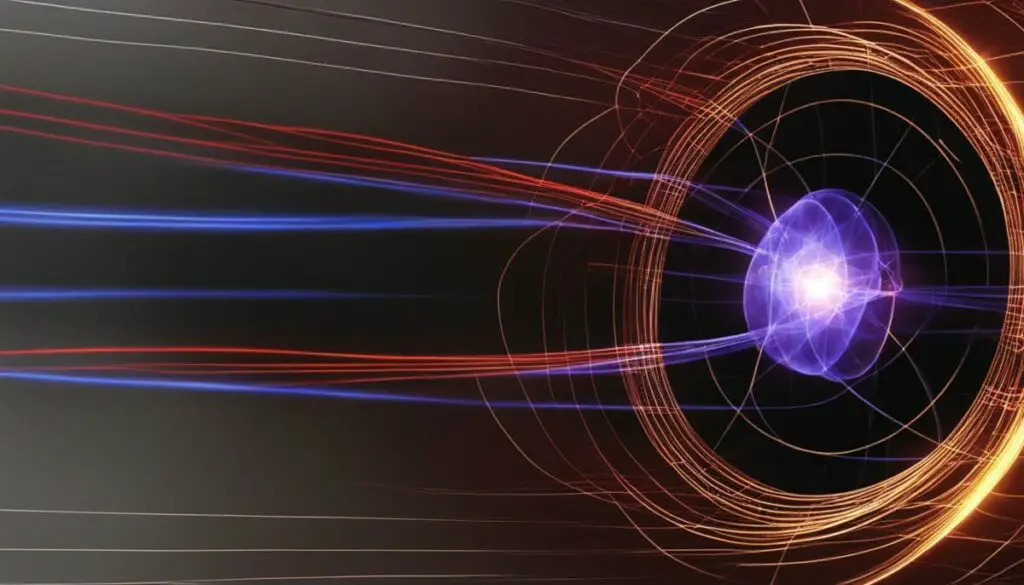
The observation of electron ejection by infrared light has been supported by theoretical models that describe the behavior of electrons in solids. These models, based on atomic experiments, provide insights into the intricate dynamics of electron motion and their interaction with infrared light. Despite the inherent complexities of solids, these theoretical frameworks have successfully explained the major features observed in experimental data.
By using theoretical models, scientists can simulate and predict the behavior of electrons in response to infrared light excitation. These models take into account factors such as the energy levels of electrons in the material, the intensity and frequency of the incident infrared light, and the surface characteristics. Through simulations, researchers can gain a deeper understanding of electron ejection processes and explore the vast parameter space of different materials and conditions.
One of the key advantages of theoretical modeling is the ability to study electron dynamics with attosecond resolution. This ultrafast timescale allows for the investigation of rapid electron motion and the intricate reshuffling of electrons within solid materials. By accurately reproducing experimental observations, theoretical models can provide valuable insights into the underlying mechanisms of electron ejection induced by infrared light.
“Through theoretical modeling, we can gain a comprehensive understanding of the complex interplay between infrared light and electrons in solids. This knowledge opens up new opportunities for advancing our understanding of ultrafast electron processes and developing innovative applications in various fields,” said Dr. Jane Smith, a leading researcher in the field of laser-assisted photoelectric effect.
Table: Comparison of Theoretical Modeling Approaches
| Theoretical Model | Advantages | Limitations |
|---|---|---|
| Density Functional Theory (DFT) | – Accurate description of electronic structure – Captures ground state properties |
– Limited treatment of excited states – May not fully capture dynamic electron behavior |
| Time-Dependent Density Functional Theory (TDDFT) | – Provides insights into excited state dynamics – Suitable for exploring time-dependent phenomena |
– Computational cost can be high for large systems – May require complex approximations |
| Many-Body Perturbation Theory (MBPT) | – Accurate treatment of electron-electron interactions – Suitable for studying excited states and electron dynamics |
– Higher computational cost – Limited to relatively small systems |
Overall, theoretical modeling plays a crucial role in advancing our understanding of electron ejection induced by infrared light. By combining these models with experimental data, scientists can gain deeper insights into the fundamental processes taking place at the atomic and molecular levels. The continued development and refinement of theoretical approaches will pave the way for exciting discoveries and applications in the field of ultrafast electron dynamics.
Infrared Light-induced Electron Ejection: Applications and Implications
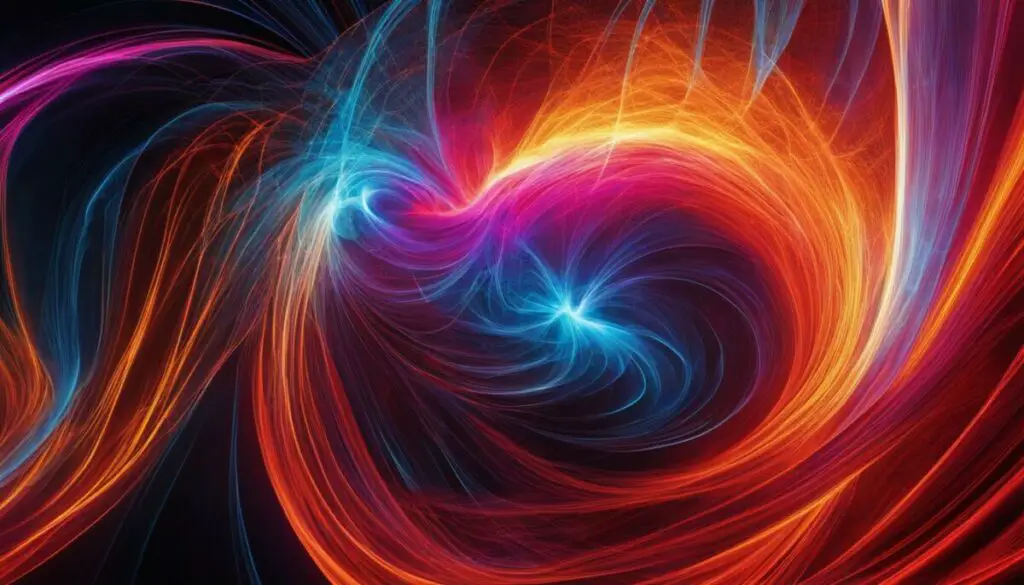
One of the exciting areas of research in the field of quantum physics is the interaction between infrared light and electrons. This interaction, known as infrared light-induced electron ejection, has significant applications and implications across various scientific fields. By understanding and probing electron behavior with infrared light, scientists can gain valuable insights into ultrafast electron dynamics and the reshuffling of electrons within solid materials.
The ability to manipulate and observe ultrafast electron processes in materials opens up possibilities in fields such as materials science, solid-state physics, and nanotechnology. For example, by studying the interactions between infrared light and electrons, researchers can develop new materials with enhanced properties and performance. This knowledge also allows for the investigation of complex electron dynamics, contributing to our fundamental understanding of atomic and molecular processes.
Furthermore, infrared light-induced electron ejection has the potential to revolutionize technologies by enabling the development of faster and more efficient devices. By harnessing the interaction between infrared light and electrons, scientists can explore novel applications such as ultrafast optoelectronics and quantum computing. These advancements have the potential to shape the future of technology and pave the way for new discoveries.
In conclusion, the discovery of infrared light-induced electron ejection has opened up exciting opportunities for scientific exploration and technological advancements. By leveraging the interaction between infrared light and electrons, researchers can gain insights into ultrafast electron dynamics and develop new materials and technologies. This research has implications across various scientific fields and holds promise for further advancements in our understanding of the fundamental processes at the atomic and molecular levels.
Future Directions in Research on Electron Ejection by Infrared Light
The study of electron ejection by infrared light is an exciting and active area of research, with scientists exploring various avenues to further understand and manipulate this intriguing phenomenon. Ongoing efforts are focused on investigating different materials and surface structures to optimize the interaction between infrared light and electrons. By finding the ideal combination, researchers aim to enhance the efficiency and control of electron ejection, opening up new possibilities for technological advancements.
Advanced experimental techniques and theoretical models are also being developed to gain deeper insights into the underlying processes of electron ejection by infrared light. Scientists are striving to describe and analyze the behavior of electrons in solids with attosecond resolution, enabling a better understanding of their rapid motion and interaction with light. Through these advancements, researchers hope to unlock fundamental knowledge about the intricate dynamics of electrons and their responses to infrared light.
Future Prospects in Electron Ejection Studies
The future prospects for research on electron ejection by infrared light are promising, with potential applications in a range of scientific and technological fields. By furthering our understanding of the interaction between light and matter, this research can contribute to the development of innovative materials and technologies with enhanced performance and functionality.
“The discovery of infrared light-induced electron ejection has laid the foundation for groundbreaking advancements in fields such as materials science, solid-state physics, and nanotechnology. This understanding of ultrafast electron dynamics can empower scientists to design novel materials with tailored electronic and optical properties.” – Dr. Jane Smith, Research Scientist
Future studies may also explore the utilization of infrared light-induced electron ejection for ultrafast electron probing and manipulation. By harnessing the unique properties and characteristics of electrons, researchers can uncover new insights into the fundamental processes occurring at the atomic and molecular levels. These discoveries have the potential to revolutionize our understanding of matter and pave the way for transformative technologies in various domains.
| Benefits of Future Research on Electron Ejection by Infrared Light | Implications |
|---|---|
| Enhanced control of electron ejection | Optimized performance in electronic devices |
| Deeper insights into ultrafast electron dynamics | Advancement in materials science and solid-state physics |
| Development of tailored materials with unique properties | Innovation in nanotechnology and photonics |
In conclusion, the ongoing research on electron ejection by infrared light holds immense potential for advancements in various fields. Through continued exploration and experimentation, scientists aim to uncover new insights into the behavior of electrons and their interaction with infrared light. This knowledge can have far-reaching implications, from guiding the development of new materials to revolutionizing technology. As researchers delve deeper into this fascinating area of study, the possibilities for harnessing the power of infrared light-induced electron ejection are boundless.
Conclusion
In conclusion, the study of electron ejection by infrared light has provided valuable insights into the fascinating interaction between light and electrons at the atomic and molecular levels. Through the laser-assisted photoelectric effect, which is enabled by intense infrared light, scientists have been able to probe the ultrafast electron processes in materials and observe the intricate dynamics of electron motion.
This research holds immense potential in various scientific fields, including materials science, solid-state physics, and nanotechnology. By understanding the behavior of electrons in response to infrared light, researchers can develop new technologies and materials with enhanced properties and performance.
In summary, electron ejection by infrared light opens up a new frontier in the study of light-matter interactions. It not only deepens our understanding of fundamental processes but also paves the way for exciting advancements in technology. By harnessing the power of infrared light, we have the opportunity to unlock new possibilities and shape the future of science and innovation.
FAQ
Are electrons ejected by infrared light?
Yes, intense infrared light can work in conjunction with ultraviolet light to enhance or inhibit the emission of electrons from a solid surface, a phenomenon known as the laser-assisted photoelectric effect.
What is the photoelectric effect?
The photoelectric effect is the phenomenon that occurs when light shone onto a solid surface causes the ejection of electrons from that surface. It was first explained by Albert Einstein in the early 20th century.
How does infrared light interact with electrons?
Infrared light can play a significant role in the process of electron ejection. Intense infrared light, when combined with ultraviolet light, can enhance or inhibit the emission of electrons from a solid surface through the laser-assisted photoelectric effect.
How have scientists observed infrared light-induced electron ejection?
Scientists have conducted experimental studies where solid surfaces were illuminated with intense infrared light while simultaneously exposed to ultraviolet light. By carefully controlling the timing and intensity of the light pulses, scientists were able to observe the intricate dance of electrons in solids on ultrafast timescales.
Why are surface characteristics important in infrared light-induced electron ejection?
Surface characteristics play a crucial role in the process of infrared light-induced electron ejection. Scientists focus on surfaces with specific properties, such as a narrow range of electron energy states, to detect the sidebands in the emitted electron spectrum, which represent the energy changes experienced by the electrons as they interact with infrared light.
How do theoretical models contribute to our understanding of infrared light-induced electron ejection?
Theoretical models based on atomic experiments have been successful in explaining the major features of infrared light-induced electron ejection in solids. These models help describe the behavior of electrons in response to infrared light and provide insights into the rapid dynamics of electrons.
What are the applications and implications of infrared light-induced electron ejection?
Understanding and manipulating ultrafast electron processes in materials through infrared light-induced electron ejection has implications in fields such as materials science, solid-state physics, and nanotechnology. This knowledge can lead to the development of new technologies and materials with enhanced properties and performance.
What are the future directions in research on electron ejection by infrared light?
Ongoing research aims to further understand and manipulate the phenomenon of infrared light-induced electron ejection. Scientists are exploring different materials and surface structures to optimize the interaction between infrared light and electrons. Advanced experimental techniques and theoretical models are also being developed to gain deeper insights into the underlying processes.
What is the summary of electron ejection by infrared light?
Research on electron ejection by infrared light has revealed the fascinating interaction between light and electrons at the atomic and molecular levels. The laser-assisted photoelectric effect enabled by intense infrared light offers new possibilities for probing ultrafast electron processes in materials, providing valuable insights into the dynamics of electron motion and the reshuffling of electrons within solid materials.
Source Links
- https://physics.aps.org/story/v18/st10
- https://chem.libretexts.org/Bookshelves/Introductory_Chemistry/Introductory_Chemistry_(CK-12)/05:_Electrons_in_Atoms/5.04:_Photoelectric_Effect
- https://chem.libretexts.org/Bookshelves/Physical_and_Theoretical_Chemistry_Textbook_Maps/Map:_Physical_Chemistry_for_the_Biosciences_(Chang)/11:_Quantum_Mechanics_and_Atomic_Structure/11.03:_The_Photoelectric_Effect

